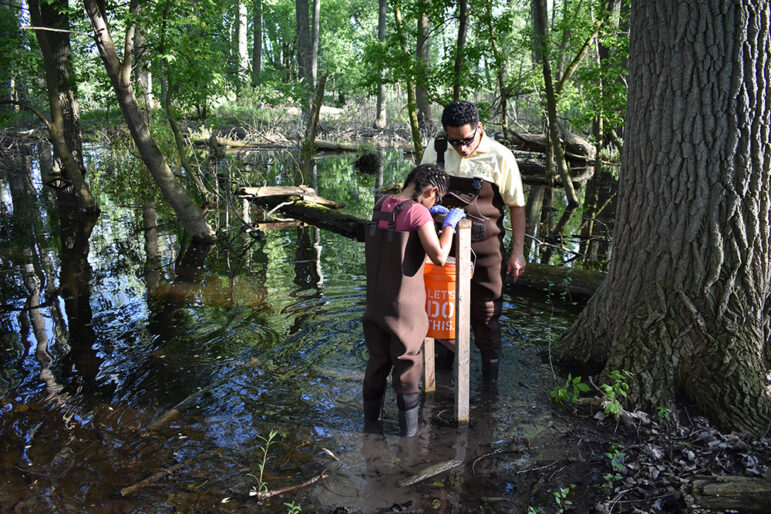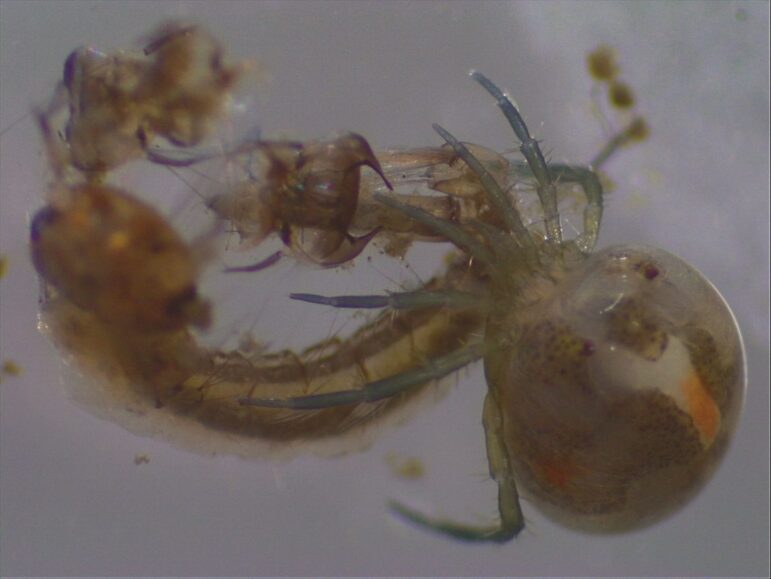By WEITING DU
Capital News Service
LANSING – Summer is here and so are the annoying mosquitoes. But so, too, are creatures that limit their number.
Water mites are close relatives of spiders and live in freshwater. Some of them can parasitize or prey on mosquitoes, according to a recent study in the journal Diversity.
Preying means one hunts and kills the other. Parasitizing means the parasite benefits at its host’s expense with or without killing it.
Understanding these water mites could be important for developing new ways to control them, the study said.
“The idea of water mites as a potential biocontrol agent for mosquitoes has been around for a while,” said Adrian Vasquez, an author of the paper and a Wayne State University researcher associated with the Cooperative Institute for Great Lakes Research. “But none of those studies were really applied in the field. So, we thought, ‘let’s give it a try.’”
To test water mites’ potential to control mosquitoes, Vasquez and his team put dozens of buckets of them in two Detroit parks. After observing the mosquito larvae, they added water mites collected from nearby.
“And then we saw the big impact of mites in some buckets where we suspect the water mites completely eradicated the mosquito larvae,” Vasquez said.
Water mites are not as well-known as their annoying hosts. But they are numerous.
Among more than 6,000 documented species of water mites in North America, scientists have found more than 30 that parasitize mosquitoes and nine that eat mosquito eggs or larvae, the study said.
Water mites could parasitize mosquito larvae and continue to limit their spread, Vasquez said. “When the host mosquito lands in an aquatic habitat to lay eggs, the mite detaches from it and falls into the water. And then the mite might start to eat mosquito larvae as it becomes an adult.”
But what water mites eat varies by species. Only a few can both prey on and parasitize mosquito larvae and adults, the study said.
Another good thing about water mites? They’re native.
“Being a native predator and parasite is a huge advantage, because there’s no concern about whether it would become an invasive species,” Vasquez said. “In Florida, people introduced mosquito fish to control mosquitoes. But the fish has become an invasive species.
“Water mites are found everywhere around here in ponds, streams and lakes,” he said. “It’s a matter of finding the ones that have the biggest impact and trying those out.”
Despite their advantages, these water mites are far from becoming biocontrol agents.
“One of the biggest limitations is that we still don’t know enough about water mites,” Vasquez said. “And the second one is how to grow them up. Some scientists have reported culturing them in the lab, but I imagine that’s very technical and challenging.”
Another challenge is stimulating the mites’ appetite for mosquitoes, another expert said.
“I think the biggest challenge is to raise the prevalence and intensity of parasitism,” said Thomas Simmons, a biology professor at the Indiana University of Pennsylvania, who was involved in another mite-mosquito study. “Low intensity means you don’t find a high number of individual larvae on any parasitized mosquito.”
There are examples of intense parasitism. Previous studies have shown that two species of mites can reduce around 20% of the cattail mosquito population through parasitizing, Simmons said. The cattail mosquito is an unusual mosquito transmits viruses like West Nile and eastern equine encephalomyelitis.
“You still have 70% to 80% of mosquitoes,” Simmons said. “But any reduction helps. Maybe you could couple that with other controls or less chemical use. It would be helpful because mosquitoes are so prolific.”
Mites could be an additional option for mosquito control, said Carl Doud, the director of Midland County Mosquito Control.
There are few options for controlling mosquitoes in the containers that hold water where they often breed, Doud said. One is BTI, a group of bacteria that are effective in killing various species of mosquitoes.
“If it’s a bucket, we will talk with the owner and just ask them to dump it,” Doud said, “But if it’s something larger, like an old boat that sunk and is uncovered, adding mites to it may control the mosquito population in that environment.”
Other factors include a more balanced ecosystem.
Vasquez said, “It’s probably not going to be as easy as just having a bucket of mites and tossing them everywhere to kill all the mosquitoes. Some of them cannot handle the pollution in the water. What you might think about is improving the environment in general rather than having one quick and easy way to get rid of mosquitoes.”
Vasquez and his team are continuing to investigate to find out more about mites.
“There are many things we would like to know,” Vasquez said, “For example, how is the mite able to capture the mosquito larvae? Does it inject some venom or something to paralyze the mosquito? How does its digestive system work? Those studies are still ongoing.”
Public health authorities are interested in the mites’ ability to control mosquito-borne diseases.
Simmons said, “In the early 2010s, we developed a collaboration with the Pennsylvania Department of Environmental protection’s West Nile virus control program. We got a huge collection of mosquitoes parasitized by water mites from them.”
By identifying those water mites and mosquitoes, researchers found a lot of new pairs of mites and the mosquitoes they parasitize, Simmons said.
“In terms of number, I think that is still the largest survey of mosquitoes to date anywhere,” Simmons said.
After the Zika virus hit the U.S. in 2016, Simmons and his team checked if a water mite can parasitize the Asian tiger mosquito, the carrier of viruses like Zika, dengue, West Nile and eastern equine encephalomyelitis.
Out of thousands of mosquitoes examined, they found one mite that parasitizes on an Asian tiger mosquito. Their next step is to look at more mites and mosquitoes from Long Island, New York, where they work with the Suffolk County Department of Health Services.
“There are around 1,000 mosquitoes sitting in the freezer, waiting for some tender loving care,” Simmons said.
Meanwhile, Vasquez said the water mites’ colorful appearance and high accessibility make them perfect for young scientists to study.
“Water mites can be used not only for controlling mosquitoes but also to excite and inspire young kids to do science because they are easy to catch and quite entertaining,” he said. “We show the kids how to capture water mites in the field, how to bring specimens to the lab and do some high-tech work, like DNA barcoding.”
And you never know what you can discover in these small, unknown animals, Vasquez said.

